Centauri Dreams
Imagining and Planning Interstellar Exploration
Enter the ‘Synestia’
What happens when giant objects collide? We know the result will be catastrophic, as when we consider the possibility that the Moon was formed by a collision between the Earth and a Mars-sized object in the early days of the Solar System. But Sarah Stewart (UC-Davis) and Simon Lock (a graduate student at Harvard University) have produced a different possible outcome. Perhaps an impact between two infant planets would produce a single, disk-shaped object like a squashed doughnut, made up of vaporized rock and having no solid surface.
Call it a ‘synestia,’ a coinage invoking the Greek goddess Hestia (goddess of the hearth, family, and domestic life, although the authors evidently drew on Hestia’s mythological connections to architecture). Stewart and Lock got interested in the possibility of such structures by asking about the effects of angular momentum, which would be conserved in any collision. Thus two giant bodies smashing into each other should result in the angular momentum of each being added together. Given enough energy (and there should be plenty), the hypothesized structure should form, an indented disk much larger than either planet.
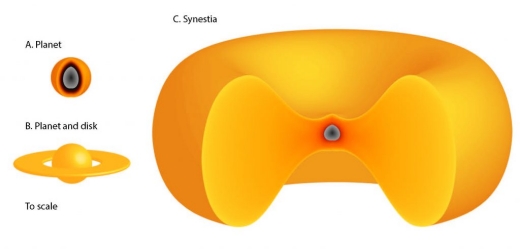
Image: The structure of a planet, a planet with a disk and a synestia, all of the same mass. Credit: Simon Lock and Sarah Stewart.
Moreover, this process should be widespread (if generally short-lived) in young, evolving planetary systems. As planet formation ends, planetary collisions should produce rapidly rotating, partially vaporized rocky objects. The researchers developed a computer code called HERCULES that allows them to calculate the physical structures of bodies in varying temperatures and rotational states. There are combinations of rotational rate and thermal energy that make it impossible for a planet to rotate like a solid body. Instead, we get an inner region with its own rotation connecting to a disk-like outer region moving at orbital velocities.
The paper on this work notes that “…the structure of post-impact bodies influences the physical processes that control accretion, core formation and internal evolution. Synestias also lead to new mechanisms for satellite formation.” Moreover, Stewart and Lock believe that rocky planets are vaporized multiple times during their formation. Thus synestias should be a common outcome in young systems. From the paper:
…there is a corotation limit for the structure of terrestrial bodies that depends on mass, compositional layering, thermal state, and AM [angular momentum]. We have named super-CoRoL [corotation limit] structures synestias. Synestias typically consist of an inner corotating region connected to an outer disk-like region. By analyzing the results of N-body simulations of planet formation, we found that high-entropy, highly vaporized post-impact states are common during terrestrial planet accretion. Given the estimated range of planetary AM during the giant impact stage, we find that many post-impact structures are likely to be synestias.
Remember that a sufficiently large impact will have produced molten or gaseous material in vast quantities, expanding in volume and responding to all that angular momentum. One outcome, given the size of the impacting objects and the energy involved, could be a disk of material surrounding the impacted planet. But the researchers believe a synestia is likely at some point, perhaps lasting as little as a hundred years. For the same amount of mass, a synestia would be much larger than a solid planet with a disk of material around it.
Could we ever hope to observe such an object given how short its lifetime is expected to be? Perhaps, and not just by a stroke of good luck. For Stewart and Lock argue that a synestia formed from larger objects like gas giants or even stars could potentially last much longer. That would make a synestia a possible observable in young extrasolar systems. With that in mind, it will be interesting to see whether the HERCULES code produced in this work will find its way into new studies of planet formation and evolution.
The paper is Lock & Stewart, “The structure of terrestrial bodies: Impact heating, corotation limits, and synestias,” Journal of Geophysical Research: Planets 122 (2017). Abstract / preprint.

TRAPPIST-1h: Filling in the Picture
One of the worst things we can do is to get so wedded to a concept that we fail to see conflicting information. That’s true whether the people involved are scientists, or stock brokers, or writers. It’s all too easy to distort the surrounding facts because we want to get a particular result, a process that is often subtle enough that we don’t notice it. Thus I was interested in what Rodrigo Luger said about his recent work on the outermost planet of TRAPPIST-1:
“It had me worried for a while that we were seeing what we wanted to see. Things are almost never exactly as you expect in this field — there are usually surprises around every corner, but theory and observation matched perfectly in this case.”
And that’s just it — in exoplanet research, we’ve come to expect the unexpected. So when Luger (a doctoral student at the University of Washington) went to work on this intriguing star some 40 light years from Earth, and its seven now famous planets, he was understandably edgy. Would TRAPPIST-1h turn out to orbit just where his team had projected?
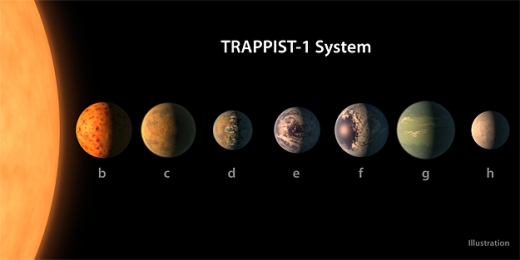
Image: A size comparison of the planets of the TRAPPIST-1 system, lined up in order of increasing distance from their host star. The planetary surfaces are portrayed with an artist’s impression of their potential surface features, including water, ice, and atmospheres. Credit: NASA/R. Hurt/T. Pyle.
You’ll recall that it was the original survey led by Michaël Gillon (University of Liège, Belgium) that identified three planets around TRAPPIST-1 in 2016, a number that jumped to seven in a 2017 paper that drew worldwide attention, especially because several of the planets appeared to be within the star’s habitable zone. TRAPPIST-1h was a problem because Gillon and team were only able to observe a single transit. What Luger proceeded to do, working with Gillon as one of his co-authors, was to follow up on that work with an international effort that studied 79 days of K2 data, snaring four transits of TRAPPIST-1h in the process.
The bit about seeing what you want to see comes from the fact that the planets of TRAPPIST-1 are locked into an orbital resonance, making their orbital periods mathematically related. Luger and colleagues wanted to use the orbital velocities of the better understood TRAPPIST-1 planets to make a prediction about the orbital velocity and period of TRAPPIST-1h. Six possible resonant periods for the planet came out of these calculations, but subsequent data ruled out all but one. Would resonance unlock the problem?
The answer was yes. The K2 data confirmed the prediction, showing us that TRAPPIST-1h is in a frigid 18.77 day orbit around the ultracool dwarf star. At this distance from the host, the planet receives about as much energy per unit area from its star as Ceres receives from the Sun.
Image: The animation shows a simulation of the planets of TRAPPIST-1 orbiting for 90 Earth-days. After 15 Earth-days, the animation focuses only on the outer three planets: TRAPPIST-1f, TRAPPIST-1g, TRAPPIST-1h. The motion freezes each time two adjacent planets pass each other; an arrow appears pointing to the location of the third planet. This complex but predictable pattern, called an orbital resonance, occurs when planets exert a regular, periodic gravitational tug on each other as they orbit their star. The three-body resonance of the outer three planets causes the planets to repeat the same relative positions, and expecting such a resonance was used to predict the orbital period of TRAPPIST-1h. Credit: Daniel Fabrycky/University of Chicago.
So now we have a seven-planet chain of resonances. We’ve seen other multi-planet resonances — four-planet resonances exist at Kepler-80 and Kepler-223 — but TRAPPIST-1, as in so many things, ups the ante considerably. The resonance picture here also gives us ideas about the history of this system, which is thought to be somewhere between 3 billion and 8 billion years old (and if that range of possibilities isn’t a reminder of how much we have to learn about dating cool stars like this, I don’t know what is).
From the paper:
The resonant structure of the system suggests that orbital migration may have played a role in its formation. Embedded in gaseous planet-forming disks, planets growing above ? 1 MMars create density perturbations that torque the planets’ orbits and trigger radial migration. One model for the origin of low-mass planets found very close to their stars proposes that Mars- to Earth-sized planetary embryos form far from their stars and migrate inward. The inner edge of the disk provides a migration barrier such that planets pile up into chains of mean motion resonances.
Thus we’re looking at possible migration inward of a set of planets that migrated in what Luger calls ‘lock-step.’ Suddenly TRAPPIST-1 becomes an excellent test case not only for planet formation but planet migration theories. The paper continues:
This model matches the observed period ratio distribution of adjacent super-Earths if the vast majority (? 90%) of resonant chains become unstable and undergo a phase of giant impacts. Some resonant chains do survive, and a handful of multiple-resonant super-Earth systems have indeed been characterized. The TRAPPIST-1 system may thus represent a pristine surviving chain of mean motion resonances.
This would have been, the authors believe, a slow migration given the low mass of the TRAPPIST-1 planet-forming disk, and the fact that the planets themselves are low in mass. Perhaps this explains why the TRAPPIST-1 resonant chain is less compact than in systems with more massive planets, and why its unique stability has survived.
And what more can I say about K2? Despite everything going against the TRAPPIST-1h work, including not just the drift and jitter of the spacecraft in its less than optimum state but the faintness of the occasionally flaring target, K2 nonetheless delivered the goods. It’s a real testimony to those working the mission that we’re still pulling useful data out of the K2 observations, and testimony as well to the quality of the team working TRAPPIST-1h.
The paper is Luger et al.,”A seven-planet resonant chain in TRAPPIST-1,” Nature Astronomy 1 (2017), 0129 (abstract / preprint).

Best Images Yet of Fomalhaut Debris Disk
The ongoing dimming of Boyajian’s Star will result in a flood of new data from a wide variety of instruments worldwide, excellent news for those trying to piece together what is happening here. I hope you saw Tabetha Boyajian’s interview with David Kipping over the weekend, but if not, you can see it archived here. I tracked the story on Twitter all weekend, and as I did so, I was reminded of the recent news about Fomalhaut, where massive comets may explain what we are seeing in the star’s debris disk. You’ll recall that early in the work on Boyajian’s Star, comets were one explanation for its anomalous light curves, and it will be interesting to see whether the cometary hypothesis can stand up to the influx of new information.
Interesting as well to look at the new data in terms of Kepler’s, asking whether this is a periodic dimming, and hence not the result of intervening material between us and the star.
Latest photometry from last night; this event seems to have ended, but remember than in Q16 they came in clumps.@tsboyajian pic.twitter.com/serFLLFXL9
— Jason Wright (@Astro_Wright) May 22, 2017
We’ll see! And as I continue to keep one eye on my Twitter feed, let me segue into Fomalhaut.
A Stunningly Imaged Debris Disk
The ALMA radio telescope (Atacama Large Millimeter/submillimeter Array) has given us the first complete view of the star’s prominent circumstellar disk in millimeter-wavelength light. One of the brightest stars in our sky, Fomalhaut (? Piscis Austrini) is about 25 light years from the Sun, an A-class star whose excess emission in the infrared has flagged the presence of a circumstellar disk. We actually have a K-class star here as well (TW Piscis Austrini) and an M-class dwarf (LP 876-10), making up a widely spaced triple system. And around it we have a band of icy dust some 2 billion kilometers wide, circling the star 20 billion kilometers out.
What is striking about the composite image (incorporating Hubble’s optical data in blue as well as the ALMA results) is how well-defined the disk of debris and gas appears. We had earlier ALMA imagery taken when the array was still under construction in 2012 that showed about half of the debris disk, but we now get the complete view, one whose data reveal similarities between cometary material in our own Solar System and the debris around Fomalhaut.
“ALMA has given us this staggeringly clear image of a fully formed debris disk,” said Meredith MacGregor, an astronomer at the Harvard-Smithsonian Center for Astrophysics in Cambridge, Mass., and lead author on one of two papers accepted for publication in the Astrophysical Journal describing these observations. “We can finally see the well-defined shape of the disk, which may tell us a great deal about the underlying planetary system responsible for its highly distinctive appearance.”
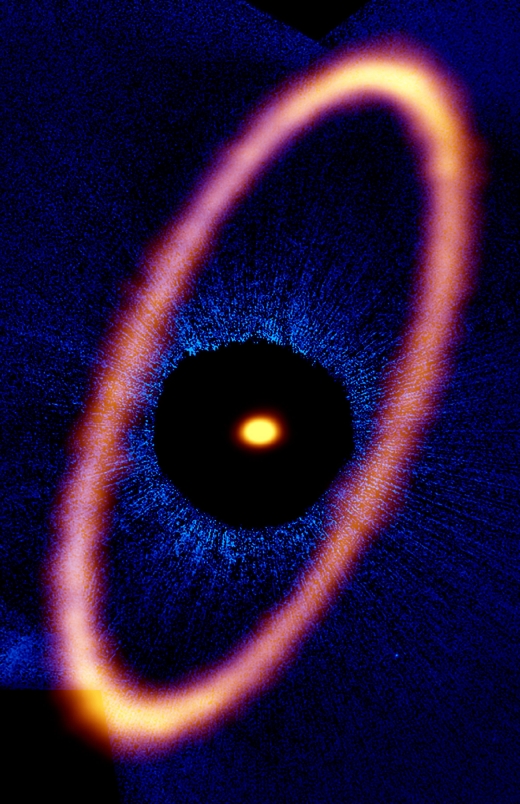
Image: Composite image of the Fomalhaut star system. The ALMA data, shown in orange, reveal the distant and eccentric debris disk in never-before-seen detail. The central dot is the unresolved emission from the star, which is about twice the mass of our sun. Optical data from the Hubble Space Telescope is in blue; the dark region is a coronagraphic mask, which filtered out the otherwise overwhelming light of the central star. Credit: ALMA (ESO/NAOJ/NRAO), M. MacGregor; NASA/ESA Hubble, P. Kalas; B. Saxton (NRAO/AUI/NSF).
You’ll also note in both images in today’s post that the disk seems brighter in two places, at about the 1 and 7 o’clock positions. This is intriguing: It tracks a prediction made last year by MIT’s Margaret Pan, who contributed to both the papers that have just appeared on the ALMA work. Pan pointed out that the dusty material in the Fomalhaut disk travels more slowly at apoapsis, when the disk is at its furthest from the star. The slowdown allows denser concentrations of dust to form, which show up as bright millimeter-wavelength emission.
This is a relatively young system at 440 million years old, making it about a tenth the age of our Solar system, and we may be seeing a system going through its own version of our Late Heavy Bombardment. Some 4 billion years ago, the Earth was frequently impacted by asteroids and comets, material left over from the formation of the system.
The Fomalhaut system is also familiar in that carbon monoxide shows up strongly in the ALMA findings. The data peg the relative abundance of carbon monoxide and carbon dioxide around Fomalhaut as roughly similar to what we see in comets found in our Solar System. Comet collisions may be releasing the gas in these quantities, perhaps even the impacts of huge comets of the kind that some have suggested around the enigmatic Boyajian’s Star.
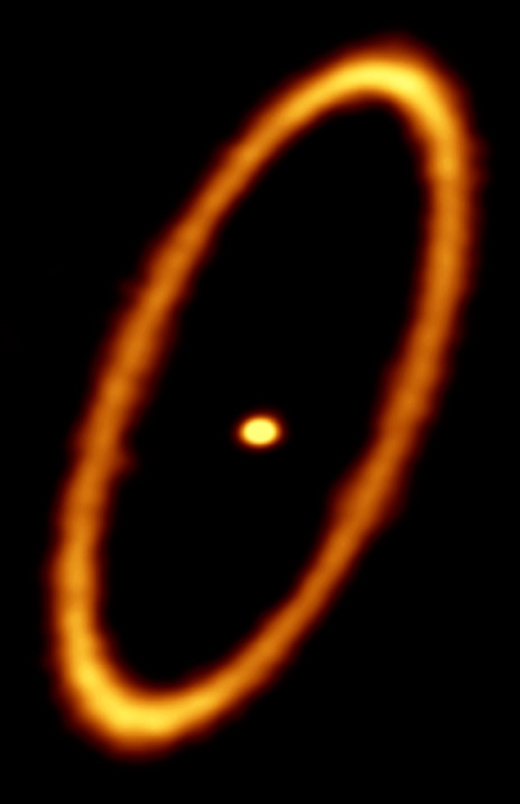
Image: ALMA image of the debris disk in the Fomalhaut star system. The ring is approximately 20 billion kilometers from the central star and about 2 billion kilometers wide. The central dot is the unresolved emission from the star, which is about twice the mass of our sun. Credit: ALMA (ESO/NAOJ/NRAO); M. MacGregor.
We already have an intriguing object here in the form of Fomalhaut b, which has been directly imaged, in a 1700 year highly elliptical orbit with apastron at about 300 AU. It is currently 110 AU from its host. Are there planets within the ring? Evidence points in that direction. The researchers were able to develop computer models that, along with the ALMA data, helped them calculate the width and geometry of the Fomalhaut disk. The disk has similarities to our own Kuiper Belt, as the paper notes, and its shape is telling:
The Fomalhaut debris disk is similarly narrow to the main classical Kuiper Belt in our own Solar System, which is radially confined between the 3:2 and 2:1 orbital resonances with Neptune implying a fractional width of ? 0.18 (Hahn & Malhotra 2005). In contrast, both the HD 107146 (Ricci et al. 2015) and ? Corvi (Marino et al. 2017) debris disks appear much broader with fractional widths of > 0.3.
That very narrowness has been seen as an indicator of planets, and not just by the authors of the current papers. But compelling as the evidence is, it is not yet conclusive:
Boley et al. (2012) propose that the narrow ring observed in Fomalhaut may also result from interactions with planets, namely two shepherding planets on the inner and outer edges of the belt. If the structure of the belt is indeed due to truncation by interior and exterior planets, we would expect to see sharp edges. However, given the resolution of our observations (? 10 AU) compared with the width of the belt (? 14 AU), we are unable to place any strong constraints on the sharpness of the disk edges.
Seeing the Fomalhaut disk at his level of detail gives us insights into early planet formation as we try to tease out the underlying planetary system that seems to be emerging. And the chemical similarities within this band and comets in our own system tell us that the processes occurring here may well parallel conditions in our own outer system’s infancy.
The papers are Macgregor et al., “A Complete ALMA Map of the Fomalhaut Debris Disk” (preprint) and Matrà et al., “Detection of exocometary CO within the 440 Myr-old Fomalhaut belt: a similar CO+CO2 ice abundance in exocomets and Solar System comets,” accepted at the Astrophysical Journal (preprint).

New Dip for Boyajian’s Star
Twitter action has been fast and furious with this morning’s news of the first clear dip in light from Boyajian’s Star (KIC 8462852) since the Kepler data.
#TabbysStar IS DIPPING! OBSERVE!! @NASAKepler @LCO_Global @keckobservatory @AAVSO @nexssinfo @NASA @NASAHubble @Astro_Wright @BerkeleySETI
— Tabetha Boyajian (@tsboyajian) May 19, 2017
I’m on the road most of today and so couldn’t get off a full post, but I did want to pass along Tabetha Boyajian’s newsletter, short but sweet.
Hello all,
We have detected a dip in progress!
Not much time to share details – we are working hard coordinating followup observations.
Here is a snapshot of LCO data for the Month of May. Stay tuned!
~Tabby et al.

And here is Jason Wright’s video chat on this event during his visit to UC Berkeley.

Detecting Photosynthesis on Exoplanets
Although many of the nearby stars we will study for signs of life are older than the Sun, we do not know how long it takes life to emerge or, for that matter, how likely it is to emerge at all. As we saw yesterday, that means plugging values into Drake-like equations to estimate the possibility of detecting an alien civilization. We can’t rule out the possibility that we are surrounded by planets teeming with non-sentient life, fecund worlds that have no heat-producing technologies to observe. Fortunately, we are developing the tools for detecting life of the simplest kinds, so that while a telescope of Colossus class can be used to detect technology-based heat signatures, it can also be put to work looking for simpler biomarkers.
Svetlana Berdyugina (Kiepenheuer Institut für Sonnenphysik and the University of Freiburg), now a visiting scientist at the University of Hawaii, has been leading a team on such detections and spoke about surface imaging of Earth-like planets at the recent Breakthrough Discuss conference. The emphasis was on Proxima b, but these techniques can be applied to many other systems within the 60 light year radius that Colossus should be capable of probing.
https://www.youtube.com/watch?v=qAC_SttPBE0&w=500&h=416
Studying exoplanets in different orbital phases allows us to acquire a surprising amount of information, using techniques that have already been deployed for the study of the surfaces of stars. We have to take into account factors like clouds, seasonal variation in albedo, and the variability of the host star as we consider these matters, but given the signal-to-noise ratios that the specs for a Colossus-like telescope imply, we should be able to discern not only variations between land masses and oceans but the photosynthetic biosignature of local plant coverage.
Berdyugina’s team includes Jeff Kuhn (University of Hawaii), and university colleagues David Harrington and John Messersmith, along with Tina Šantl-Temkiv (Aarhus University, Denmark). The idea they have explored in a 2016 paper in the International Journal of Astrobiology (citation below) is to use the properties of light to detect photosynthesis.
What can we say about the detectability of biomolecules that capture photons and store their energy in chemical bonds? In green plants, the resulting chemical energy converts water, carbon dioxide, and minerals into oxygen and energy-rich organic compounds. Photosynthetic pigments can absorb solar light in the visible range and create the chemical bonds with which it can be stored for use. Chlorophyll pigments, for example, absorb blue to red light while reflecting some part of the green at visible wavelengths, which accounts for our perception of green plants. The useful fact is that all incident infrared light is reflected, giving us a marker if we can find a way to observe it. This sharp rise in reflectivity has been called ‘the red edge.’
We use these facts already in studying our own planet through Earth-observing satellites like Landsat, which can map changes to Amazon forest cover by imaging in multiple bands falling on either side of the ‘red edge.’ I also note work from Giovanna Tinetti (University College London), which estimates that 20 percent of a planet’s surface must be covered by plants and free from clouds in order for the imprint of vegetation to show up in a global spectrum. It will be interesting to see whether, as it continues to develop, Berdyugina’s work agrees with this figure.
But back to the paper. The key to the work is polarization, the oscillation of light in certain directions as opposed to light that oscillates in all directions at once. We learn that the infrared light reflected by a leaf is polarized nowhere near as markedly as the visible light reflected off it. This means that polarizing filters can be used with sufficient contrast to detect biopigments, each of which, like chlorophyll, has its own signature in polarized light. Moreover, the current work shows that polarized light can distinguish clearly between the biosignatures of photosynthesis and light from oceans, minerals and atmospheres.
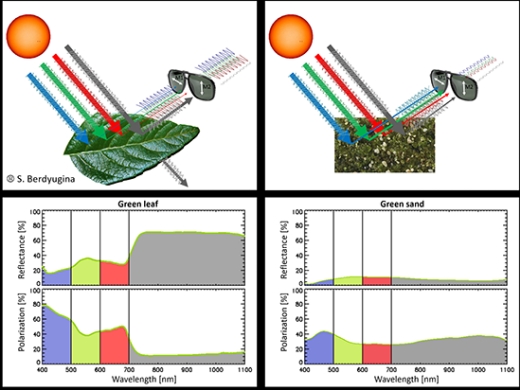
Image: A green leaf absorbs almost all red, green and blue light (RGB), but it reflects and transmits infrared light (shown in grey). The reflected infrared light is only weakly polarized due to the reflection of a healthy leaf, but the reflected RGB light is strongly polarized due to biopigments. Measuring the amount of polarized light at different colors reveals the signature of the leaf biopigments. Green sand reflects and polarizes sunlight almost equally in all wavelengths, which distinguishes it from a leaf that is a similar color. Similarly, yellow plants are different from yellow sand, etc. Credit: S. Berdyugina.
In their 2016 paper, the researchers discuss their development of a detection mechanism based on polarimetry, working with a laboratory experiment measuring the optical polarized spectra of samples both biological and non-biological. The paper investigates a range of biomolecules that capture stellar photons and store their energy in chemical bonds, examining plants with various pigments and likewise measuring non-biological materials like rock and sand.
The results, drawn on modeling of the polarized spectra of Earth-like planets in a variety of configurations — degree of surface coverage by photosynthetic organisms, empty land areas and ocean — show how useful polarized spectra can be at detecting photosynthetic pigments. Bear in mind when considering future observations that even with upcoming giant telescopes, we will not be able to image a planetary surface directly. Instead, we will use changes in the rotational signature of the planet as it moves about its star to learn about surface properties.
This rotational signature should prove extremely helpful, as the paper notes, although it requires large telescopes. Moreover, the contrast achievable in detected light depends on the kind of star we are dealing with and the wavelengths we are working at. From the paper:
It is feasible that the contrast down to 10-8 can be achieved with the current technology. However, to collect the necessary amount of photons in order to achieve such a high contrast for small planets requires extremely large telescopes. It appears that 25-40 m telescopes will be able to see only a few such planets. Large telescopes, such as the 75 m Colossus telescope are needed to investigate hundreds of Earth-like planets in stellar habitable zones (Kuhn & Berdyugina, 2015), but even such large telescopes will be able to detect their light with a sufficient SNR at very low spectral resolution or in broad bands. The fact that absorption and polarization features of biopigments are extremely broad allows for filters designed to provide enough detail on their possible photosynthetic origin.
Such filters give us, in other words, a tool that can distinguish a living from a non-living world. And not just in terms of vegetation. The paper goes on to note that the same biosignature is produced by bacteria and archaea, both of which use biopigments to harvest stellar light, as well as to protect themselves from dangerous UV radiation. Applying the techniques in this paper to the study of microorganism signatures through polarized light is an ongoing project.
This work may remind you of Nancy Kiang’s work on the spectral signatures of photosynthesis at NASA Goddard. Finding the right absorption band in the spectrum of an exoplanet can be tricky, as Kiang has shown by studying the colors of pigments and how they might change depending on the spectral class of the host star (see Beyond the Red Edge). On Earth, the colors of our land plants depend upon pigments that absorb in the visible blue and red, giving us green and yellow plants, but M-class dwarfs may have their peak absorption in the blue and near-infrared part of the spectrum, as Berdyugina and colleagues note. Thus we have to bear in mind how photosynthetic pigments might adapt depending on incident starlight. From Berdyugina et al:
It is worth also to note that a lack of blue photons in cool M stars will probably require a more complex mechanism for splitting water molecules into hydrogen and oxygen involving three or four photons instead of two as it occurs in terrestrial organisms. Therefore, understanding properties of radiation reflected from various photosynthetic organisms may help to identify such life forms on distant planets. This is the primary goal of our study.
Thus the paper identifies the signatures of biological pigments that can be used for biomarker detection, developing models of Earth-like planets with different coverage conditions of land and ocean, vegetation and clouds. The investigation of polarization winds up showing that linear polarization becomes the most potent method for detection of such biomarkers, citing “…very sensitive and rather unambiguous detection of photosynthetic pigments of various kinds.”
The paper is Berdyugina et al., “Remote sensing of life: polarimetric signatures of photosynthetic pigments as sensitive biomarkers,” International Journal of Astrobiology 15 (1): 45-56 (2016). Full text.

A ‘Census’ for Civilizations
We’ve been talking about the Colossus project, and the possibility that this huge (though remarkably lightweight) instrument could detect the waste heat of extraterrestrial civilizations. But what are the chances of this, if we work out the numbers based on the calculations the Colossus team is working with? After all, Frank Drake put together his famous equation as a way of making back-of-the-envelope estimates of SETI’s chances for success, working the numbers even though most of them at that time had to be no more than guesses.
Bear in mind as we talk about this that we’d like to arrive at a figure for the survival of a civilization, a useful calculation because we have no idea whether technology-driven cultures survive or destroy themselves. Civilizations may live forever, or they may die out relatively quickly, perhaps on a scale of thousands of years. Here Colossus can give us useful information.
The intention, as discussed in a paper by Jeff Kuhn and Svetlana Berdyugina that we looked at yesterday (citation below), is to look out about 60 light years, a sphere within which we have numerous bright stars that a large instrument like Colossus can investigate for such detections. We’re making the assumption, by looking for waste heat, that civilizations living around such stars could be detected whether or not they intend to communicate.
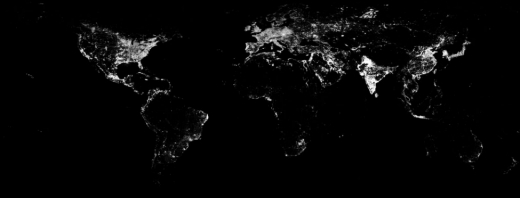
Image: Figure 1 from Kuhn & Berdyugina, “Global Warming as a Detectable Thermodynamic Marker of Earth-like Extrasolar Civilizations: The case for a Telescope like Colossus.” Caption: Man-made visible light on the Earth in 2011. From DMPS/NASA. The brightest pixels in this 0.5 × 0.5 degree resolution map have a radiance of about 0.05 × 10?6 W/cm2/sr/micron. Credit: Jeff Kuhn/Svetlana Berdyugina.
Let’s take the fraction of stars with planets as 0.5, and the fraction of those with planets in the habitable zone as 0.5, numbers that have the benefit of Kepler data as some justification, unlike Drake’s pre-exoplanet era calculations. Kuhn and Berdyugina have to make some Drake-like guesses as they run their own exercise, so let’s get really imaginative: Let’s put the fraction of those planets that develop civilizations at the same 0.5, and the fraction of those that are more advanced than our own likewise at 0.5. These numbers operate under the assumption that our own civilization is not inherently special but just one of many.
Work all this out and we can come up with a figure for the fraction of civilizations that might be out there. But how many of them have survived their technological infancy?
Let me cut straight to the paper on the outcome of the kind of survey contemplated for Colossus, which is designed to include “a quantifiably complete neighborhood cosmic survey for [Kardashev] Type I civilizations” within about 20 light years of the Sun, but one that extends out to 60 light years. In the section below, ? stands for the ratio of power production by an extraterrestrial civilization to the amount of stellar power it receives (more on this in a moment).
From the paper:
…current planet statistics suggest that out of 650 stars within 20 pc at least one quarter would have HZEs [Habitable Zone Earths]. Assuming that one quarter of those will develop ? ? 0.01 civilizations, we arrive at the number of detectable civilizations in the Solar neighbourhood ND = 40fs, where fs is the fraction of survived civilizations (i.e., civilizations that form and survive). Hence, even if only one in 20 advanced civilizations survive (including us at the time of survey), we should get a detection. Taking into account the thermodynamic nature of our biomarker, this detection is largely independent of the sociology of detectable ETCs.
Independent because we are not relying on any intent to communicate with us, and are looking for civilizations that may in fact be advanced not far beyond our own level, as well as their more advanced counterparts, should they exist.
Suppose we detect not a single extraterrestrial civilization. Within the parameters of the original assumptions, we could conclude that if a civilization does reach a certain level of technology, its probability of survival is low. That would be a null result of some consequence, because it would place the survival of our own civilization in context. We would, in other words, face old questions anew: What can we do to prevent catastrophe as a result of technology? We might also consider that our assumptions may have been too optimistic — perhaps the fraction of habitable zone planets developing civilizations is well below 0.5.
But back to that interesting figure ?. The discussion depends upon the idea that the marker of civilization using energy is infrared heat radiation. Take Earth’s current global power production to be some 15 terawatts. It turns out that this figure is some 0.04 percent of the total solar power Earth receives. In this Astronomy article from 2013, Kuhn and Berdyugina, along with Colossus backers David Halliday and Caisey Harlingten, point out that in Roman times, the figure for ? was about 1/1000th of what it is today. Again, ? stands for the ratio of power production by a civilization to the amount of solar power it receives.
The authors see global planetary warming as setting a limit on the power a civilization can consume, because both sunlight from the parent star as well as a civilization’s own power production determine the global temperature. To produce maximum energy, a civilization would surely want to absorb the power of all the sunlight available, increasing ? toward 1. Now we have a culture that is producing more and more waste heat radiation on its own world. And we could use an instrument like Colossus to locate civilizations that are on this course.
In fact, we can do better than that, because within the 60 light year parameters being discussed, we can study the heat from such civilizations as the home planet rotates in and out of view of the Earth. Kuhn and Berdyugina liken the method to studying changes of brightness on a star. In this case, we are looking at time-varying brightness signals that can identify sources of heat on the planet, perhaps clustered into the extraterrestrial analog of cities. A large enough infrared telescope could observe civilizations that use as little as 1 percent of the total solar power they intercept by combining visible and infrared observations. A low value of ? indeed.
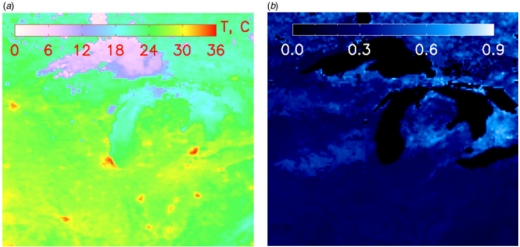
Image: Figure 3 from the Kuhn/Berdyugina paper “Global Warming as a Detectable Thermodynamic Marker of Earth-like Extrasolar Civilizations: The case for a Telescope like Colossus.” Caption: Fig. 3. Expanded view of a representative North American region illustrating temperature perturbation due to cities (left, heated cities are seen in red) and corresponding surface albedo (right). From NEO/NASA.
You can see what a challenge this kind of observation presents. It demands, if the telescope is on the ground, adaptive optics that can cancel out atmospheric distortion. It also demands coronagraph technology that can distinguish the glow of a working civilization from a star that could be many millions of times brighter. And because we are after the highest possible resolution, we need the largest possible collecting area. The contrast sensitivity at visible and infrared wavelengths of the instrument are likewise crucial factors.
I’ll refer you to “New strategies for an extremely large telescope dedicated to extremely high contrast: The Colossus Project” (citation below) for the ways in which the Colossus team hopes to address all these issues. But I want to back out to the larger view: As a civilization, we are now capable of building technologies that can identify extraterrestrial cultures at work, and indeed, instruments like Colossus could be working for us within a decade if we fund them.
We can add such capabilities to the detection of non-technological life as well, through the search for biomarkers that such large instruments can enable. More on that tomorrow, when I’ll wrap up this set on Colossus with a look at photosynthesis signatures on exoplanets. Because for all we know, life itself may be common to habitable zone planets, while technological civilization could be a rarity in the galaxy. Learning about our place in the universe is all about finding the answers to questions like these, answers now beginning to come into range.
The Colossus description paper is Kuhn et al., “Looking Beyond 30m-class Telescopes: The Colossus Project,” SPIE Astronomical Telescopes and Instrumentation (2014). Full text. The paper on Colossus and waste heat is Kuhn & Berdyugina, “Global warming as a detectable thermodynamic marker of Earth-like extrasolar civilizations: the case for a telescope like Colossus,” International Journal of Astrobiology 14 (3): 401-410 (2015). Full text.


